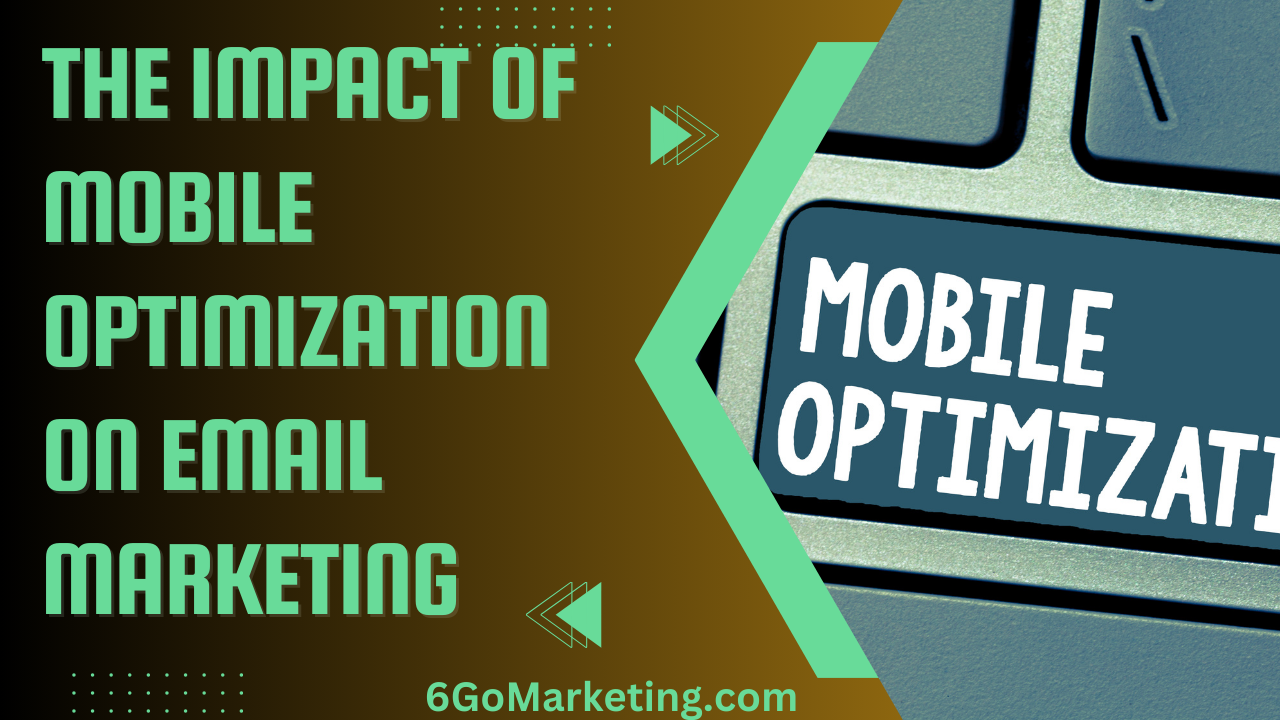In today’s digital age, mobile devices have become an integral part of our daily lives. From checking social media to reading emails, the majority of online activities now take place on mobile devices. This shift in user behavior has significant implications for email marketing.
To remain effective, marketers must ensure their email campaigns are optimized for mobile devices. This blog post explores the impact of mobile optimization on email marketing, highlighting the importance of responsive design, the benefits of mobile-friendly content, and best practices for achieving optimal results. Through facts, figures, and case studies, we will demonstrate how mobile optimization can enhance the effectiveness of email marketing campaigns.
The Rise of Mobile Email Usage
Over the past decade, mobile devices have increasingly become the preferred method for accessing emails. According to a study by Litmus, 46% of all email opens occur on mobile devices, compared to 35% on desktop and 19% on webmail. This trend is expected to continue as mobile technology advances and consumer reliance on smartphones and tablets grows.
Table 1: Email Opens by Device (2023)
| Device | Percentage of Email Opens |
|---|---|
| Mobile | 46% |
| Desktop | 35% |
| Webmail | 19% |
Given this shift, it is essential for marketers to prioritize mobile optimization in their email campaigns. Emails that are not optimized for mobile devices can result in poor user experiences, leading to lower engagement rates, higher bounce rates, and ultimately, lost revenue.
The Importance of Mobile Optimization in Email Marketing
Mobile optimization involves designing and formatting email content to ensure it displays correctly and is easily readable on mobile devices. This includes using responsive design, optimizing images, and ensuring that text is legible without the need for zooming or scrolling horizontally. The importance of mobile optimization in email marketing cannot be overstated, as it directly impacts key performance metrics such as open rates, click-through rates, and conversions.
- Improved User Experience:
- A seamless user experience is crucial for the success of any email marketing campaign. When emails are optimized for mobile devices, recipients can easily read and interact with the content, leading to higher engagement. In contrast, poorly optimized emails may appear cluttered or difficult to navigate, causing frustration and prompting users to delete the email or unsubscribe.
- According to a study by Google, 61% of users are unlikely to return to a mobile site if they had trouble accessing it, and 40% will visit a competitor’s site instead. While this statistic pertains to websites, it highlights the importance of a positive mobile experience, which is equally applicable to email marketing.
- Higher Open Rates:
- Mobile optimization can significantly impact email open rates. When emails are optimized for mobile, they are more likely to be opened and read by recipients. This is particularly important given that many users check their emails on the go, often during short breaks or while commuting. An email that loads quickly and displays correctly on a mobile device has a better chance of capturing the recipient’s attention.
- Research by Campaign Monitor found that emails optimized for mobile devices have a 24% higher open rate than non-optimized emails. This demonstrates the clear advantage of mobile-friendly email design in capturing and retaining the audience’s attention.
- Increased Click-Through Rates (CTR):
- Click-through rate is a critical metric in email marketing, as it indicates the effectiveness of the email in driving recipients to take action. Mobile optimization plays a key role in improving CTR by ensuring that calls to action (CTAs) are easily accessible and clickable on small screens. Buttons and links should be large enough to tap without difficulty, and content should be concise and to the point.
- According to a study by HubSpot, mobile-optimized emails can result in a 15% higher CTR compared to emails that are not optimized for mobile. This highlights the importance of designing emails with mobile users in mind to maximize engagement and conversions.
- Reduced Bounce Rates:
- Bounce rate refers to the percentage of emails that are sent but not delivered to the recipient’s inbox. While various factors can contribute to high bounce rates, mobile optimization can help reduce this issue by ensuring that emails are properly formatted and compliant with email client requirements. Additionally, emails that are mobile-friendly are less likely to be marked as spam, which can improve deliverability.
- Data from Return Path shows that emails with responsive design have a 9% lower bounce rate compared to non-responsive emails. By reducing bounce rates, marketers can ensure that their messages reach their intended audience and achieve better overall campaign performance.
Table 2: The Impact of Mobile Optimization on Email Marketing Metrics
| Metric | Impact of Mobile Optimization | Supporting Data/Statistics |
|---|---|---|
| User Experience | Improved readability and navigation | 61% of users unlikely to return after a poor experience (Google) |
| Open Rates | Higher likelihood of emails being opened | 24% higher open rate for mobile-optimized emails (Campaign Monitor) |
| Click-Through Rates (CTR) | Increased engagement with CTAs | 15% higher CTR for mobile-optimized emails (HubSpot) |
| Bounce Rates | Reduced likelihood of emails bouncing | 9% lower bounce rate for responsive emails (Return Path) |
Best Practices for Mobile Optimization in Email Marketing
To fully capitalize on the benefits of mobile optimization, marketers should follow best practices when designing and sending email campaigns. Below are some key strategies for ensuring that emails are optimized for mobile devices:
- Responsive Design:
- Responsive design is a technique that allows email content to adapt to different screen sizes, ensuring that it looks great on both mobile devices and desktops. This is achieved by using fluid grids, flexible images, and media queries in the email’s HTML code. With responsive design, the layout of the email automatically adjusts to fit the screen, providing an optimal viewing experience for all users.
- According to Litmus, 56% of email marketers use responsive design in their email campaigns, making it one of the most popular approaches to mobile optimization. By adopting responsive design, marketers can ensure that their emails are accessible and visually appealing on any device.
- Simplified Content:
- Mobile users typically have shorter attention spans and less time to engage with lengthy content. To accommodate this behavior, marketers should prioritize concise, scannable content in their emails. This includes using short paragraphs, bullet points, and clear headings to break up text and make it easier to read. Additionally, the most important information should be placed at the top of the email, where it is more likely to be seen.
- A study by the Nielsen Norman Group found that people read only 20-28% of the text on a web page during an average visit. This statistic underscores the importance of concise content, which is particularly relevant for mobile emails where screen space is limited.
- Optimized Images and Media:
- Images and media can enhance the visual appeal of an email, but they must be optimized for mobile devices to prevent slow loading times and poor performance. This includes using appropriately sized images, compressing files to reduce their size, and using alt text for images in case they do not load. Additionally, marketers should consider the use of video or GIFs to engage mobile users, but these should also be optimized for fast loading.
- According to Kissmetrics, a one-second delay in page load time can result in a 7% reduction in conversions. This highlights the importance of optimizing images and media for mobile emails to ensure a seamless user experience.
- Clickable and Accessible CTAs:
- Calls to action (CTAs) are one of the most important elements of an email, as they guide recipients toward the desired action, whether it’s making a purchase, signing up for a webinar, or downloading a resource. On mobile devices, CTAs must be easily clickable, with buttons large enough to tap without zooming. Additionally, CTAs should be placed prominently within the email and repeated if necessary to increase visibility.
- Research by Unbounce shows that using a single, clear CTA can increase conversions by up to 371%. For mobile emails, it’s essential to make the CTA stand out and ensure that it’s easy for users to interact with.
- Testing and Optimization:
- Before sending out an email campaign, it’s crucial to test how it will appear on various devices and email clients. Marketers should use tools like Litmus or Email on Acid to preview emails across different screen sizes and platforms. A/B testing is also essential for optimizing subject lines, content, and CTAs to determine what resonates best with the target audience.
- According to HubSpot, companies that regularly A/B test their emails see a 37% increase in email marketing ROI. By testing and optimizing mobile emails, marketers can continuously improve their campaigns and achieve better results.
Table 3: Best Practices for Mobile Optimization in Email Marketing
| Best Practice | Description | Impact on Email Performance |
|---|---|---|
| Responsive Design | Ensures emails display correctly on all screen sizes | Improved accessibility, better user experience |
| Simplified Content | Prioritizes concise, scannable content | Increased engagement, reduced bounce rates |
| Optimized Images and Media | Reduces file sizes, improves loading times | Faster load times, higher conversions |
| Clickable and Accessible CTAs | Makes CTAs easy to tap, prominently displayed | Higher click-through rates, increased conversions |
| Testing and Optimization | Previews emails on various devices, A/B tests content | Improved campaign effectiveness, higher ROI |
The Impact of Mobile Optimization on Email Marketing ROI
The ultimate goal of any email marketing campaign is to generate a positive return on investment (ROI). Mobile optimization plays a crucial role in maximizing the ROI of email marketing campaigns by improving key performance metrics such as open rates, click-through rates (CTR), and conversion rates. When emails are optimized for mobile devices, they are more likely to engage recipients, drive desired actions, and ultimately contribute to higher revenue. Below, we explore how mobile optimization directly impacts email marketing ROI and the strategies marketers can use to enhance their returns.
- Increased Conversion Rates:
- Conversion rate is one of the most critical metrics in email marketing, as it measures the percentage of recipients who complete the desired action, such as making a purchase, filling out a form, or downloading a resource. Mobile optimization directly influences conversion rates by ensuring that the email’s content, CTAs, and landing pages are all user-friendly and accessible on mobile devices.
- According to Adobe, mobile users are 64% more likely to make a purchase after clicking on a mobile-optimized email. This statistic underscores the importance of aligning the entire email experience with mobile user behavior, from the initial click to the final conversion.
- Reduced Abandonment Rates:
- One of the challenges in email marketing is reducing abandonment rates, particularly when it comes to shopping cart abandonment in e-commerce. Mobile optimization can help mitigate this issue by making it easier for users to complete the checkout process on their devices. This includes ensuring that product pages, forms, and payment gateways are all optimized for mobile.
- Data from Barilliance shows that mobile-optimized checkout experiences can reduce cart abandonment rates by up to 20%. By providing a seamless path to purchase, marketers can recover lost sales and boost overall revenue.
- Higher Customer Lifetime Value (CLTV):
- Customer lifetime value (CLTV) is a measure of the total revenue a business can expect from a customer over the course of their relationship. Mobile-optimized emails contribute to higher CLTV by fostering ongoing engagement and encouraging repeat purchases. When customers consistently receive mobile-friendly emails that resonate with their needs and preferences, they are more likely to remain loyal and continue doing business with the brand.
- A study by Salesforce found that 70% of consumers say that a company’s understanding of their individual needs influences their loyalty. By leveraging mobile optimization to deliver personalized, relevant content, marketers can strengthen customer relationships and increase CLTV.
- Improved Brand Perception:
- The quality of a brand’s email communications can significantly influence how it is perceived by its audience. Emails that are visually appealing, easy to navigate, and optimized for mobile devices reflect positively on the brand, enhancing its credibility and professionalism. Conversely, poorly optimized emails that are difficult to read or interact with can harm the brand’s reputation.
- According to a survey by BlueHornet, 80% of consumers delete an email if it doesn’t look good on their mobile device. This highlights the importance of mobile optimization in maintaining a positive brand image and ensuring that emails contribute to, rather than detract from, the brand’s overall perception.
Table 4: The Impact of Mobile Optimization on Email Marketing ROI
| Metric | Impact of Mobile Optimization | Supporting Data/Statistics |
|---|---|---|
| Conversion Rates | Higher likelihood of users completing desired actions | 64% more likely to purchase after clicking mobile-optimized email (Adobe) |
| Abandonment Rates | Reduced cart abandonment through seamless mobile experiences | 20% reduction in cart abandonment with mobile-optimized checkout (Barilliance) |
| Customer Lifetime Value (CLTV) | Increased engagement and repeat purchases | 70% of consumers influenced by personalized experiences (Salesforce) |
| Brand Perception | Enhanced credibility and professionalism | 80% of consumers delete emails that don’t look good on mobile (BlueHornet) |
Case Studies: The Impact of Mobile Optimization on Email Marketing Success
To further illustrate the benefits of mobile optimization, let’s examine a few case studies from organizations that have successfully implemented mobile-optimized email marketing strategies.
- Nike:
- Nike is a global leader in athletic footwear and apparel, known for its innovative marketing campaigns. The company recognized the growing importance of mobile and decided to revamp its email marketing strategy to ensure all emails were fully optimized for mobile devices. This involved using responsive design, simplifying content, and incorporating clear, clickable CTAs.
- As a result of these changes, Nike saw a 30% increase in mobile email click-through rates and a 17% increase in mobile-driven revenue. The success of this mobile-first approach reinforced the importance of mobile optimization in driving engagement and sales.
- Starbucks:
- Starbucks, the world’s largest coffeehouse chain, leveraged mobile optimization to enhance its email marketing efforts. The company focused on creating visually appealing, mobile-friendly emails that featured personalized offers, loyalty rewards, and easy access to its mobile app. Starbucks also optimized the checkout process within the app to ensure a seamless user experience.
- The mobile optimization strategy led to a 25% increase in email open rates and a 22% increase in mobile app usage. Additionally, Starbucks saw a significant boost in mobile orders, contributing to higher overall revenue.
- Charity: Water:
- Charity: Water, a nonprofit organization dedicated to providing clean drinking water to people in developing countries, implemented mobile optimization to improve the effectiveness of its email campaigns. The organization used responsive design, optimized images, and concise messaging to engage donors and encourage them to contribute via their mobile devices.
- The mobile-optimized email campaigns resulted in a 42% increase in donation conversions and a 35% increase in mobile traffic to the organization’s website. This success demonstrates the power of mobile optimization in driving meaningful actions, even in the nonprofit sector.
Table 5: Case Studies of Mobile Optimization Impact on Email Marketing
| Company | Key Strategies Implemented | Results Achieved |
|---|---|---|
| Nike | Responsive design, simplified content, clear CTAs | 30% increase in mobile email CTR, 17% increase in mobile-driven revenue |
| Starbucks | Visually appealing emails, personalized offers, optimized checkout | 25% increase in open rates, 22% increase in mobile app usage |
| Charity: Water | Responsive design, optimized images, concise messaging | 42% increase in donation conversions, 35% increase in mobile traffic |
Future Trends in Mobile Optimization for Email Marketing
As mobile usage continues to grow, the landscape of email marketing will evolve accordingly. Staying ahead of emerging trends will be crucial for marketers who want to maintain their competitive edge. Below are some key trends in mobile optimization that are likely to shape the future of email marketing:
- Interactive Emails:
- Interactive emails, which allow users to engage with content directly within the email (such as completing surveys, making purchases, or booking appointments), are becoming increasingly popular. These emails enhance the user experience by eliminating the need to click through to a separate landing page. Mobile optimization will be key to ensuring that interactive elements work seamlessly on smaller screens.
- AI-Powered Personalization:
- Artificial intelligence (AI) is transforming how marketers personalize email content. AI-powered algorithms can analyze user behavior and preferences to deliver highly targeted messages that resonate with individual recipients. As AI-driven personalization becomes more prevalent, mobile optimization will ensure that these personalized emails are visually appealing and functional on all devices.
- Voice-Activated Email Actions:
- With the rise of voice assistants like Siri, Alexa, and Google Assistant, voice-activated actions within emails are becoming a reality. Marketers are exploring ways to enable recipients to take actions (such as placing an order or scheduling an appointment) using voice commands. Ensuring that these actions work effectively on mobile devices will be a key consideration.
- Dark Mode Optimization:
- Dark mode, a display setting that uses a dark background with light text, is gaining popularity among mobile users. As more email clients support dark mode, marketers must ensure that their emails are optimized for both light and dark mode displays. This includes adjusting image colors, avoiding transparent backgrounds, and testing emails in both modes.
Table 6: Future Trends in Mobile Optimization for Email Marketing
| Trend | Description | Potential Impact on Email Marketing |
|---|---|---|
| Interactive Emails | Direct engagement with content within the email | Enhanced user experience, higher engagement rates |
| AI-Powered Personalization | Targeted messages based on user behavior and preferences | Increased relevance, higher conversion rates |
| Voice-Activated Email Actions | Actions triggered by voice commands | Greater convenience, expanded accessibility |
| Dark Mode Optimization | Emails designed for both light and dark mode displays | Improved readability, better user experience |
Conclusion
Mobile optimization is no longer an option in email marketing; it is a necessity. As mobile usage continues to dominate the digital landscape, ensuring that your emails are optimized for mobile devices is crucial to the success of your campaigns.
By implementing responsive design, simplifying content, optimizing images, and prioritizing clickable CTAs, marketers can enhance the user experience, drive higher engagement, and ultimately achieve better ROI.
The impact of mobile optimization on email marketing is clear: it leads to improved open rates, increased click-through rates, higher conversion rates, and stronger customer loyalty. As emerging trends like interactive emails, AI-powered personalization, and voice-activated actions gain traction, the need for mobile optimization will only grow.
By staying ahead of these trends and continuously refining their mobile optimization strategies, marketers can ensure that their email campaigns remain effective, relevant, and impactful in a mobile-first world.
By understanding the importance of mobile optimization and implementing best practices, businesses can create email campaigns that resonate with their audience and drive meaningful results in today’s mobile-centric environment.










